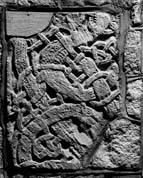Select a site alphabetically from the choices shown in the box below. Alternatively, browse sculptural examples using the Forward/Back buttons.
Chapters for this volume, along with copies of original in-text images, are available here.
Object type: Panel fragment, possibly part of a cross-shaft
Measurements: H. 47 cm (18.5 in); W. 33.5 cm (13.25 in); D. 4 cm (1.5 in)
Stone type: As Colerne 1a. Ooliths mostly project on surface of slab. Bath stone
Plate numbers in printed volume: Pl. 435
Corpus volume reference: Vol 7 p. 212-3
(There may be more views or larger images available for this item. Click on the thumbnail image to view.)
Probably part of a cross in which Colerne 1a is another panel, but whether from front or side is impossible to say.
A: This face is more worn than 1a, but one edge moulding survives, enclosing a composition based on either two or three animals, but only one beast is intact enough for characterisation. It is shown in profile with its head thrownback and body looped in a curve towards its head. Part of the head survives with half-opened mouth revealing its toothy jaws. It has a back-pointed eye, ridged and with a prominent pupil, and its narrow pointed ear extends into interlace. Its body is ribbon-like, only swelling slightly at the junction with its front leg, which seems to terminate in a bird-like claw. Where the body patterning survives, it is decorated on one side of the midrib with beaded chevrons and on the other with left to right hatching. The legs of this creature penetrate two other serpentine bodies which are decorated with pellets and with left to right hatching. The serpentine bodies cross and coil, and all are knotted together with unruly interlace which fills every space. The strands of the interlace are either median-incised, as on 1a, or beaded, and so the surface texture when original must have been very rich.
These pieces belong to a group of West Saxon carvings which are widely dispersed in place and probably in time, and which are discussed more extensively in the introduction (pp. 42–8; see Fig. 19). When first discussed by Romilly Allen he considered that 'the bodies of the beasts are more elaborately ornamented than in any other case that has come under my notice' (1894, 65), and this is still true, despite the many comparable examples of lacertine beasts which have been discovered since. The vigour, even savagery, of the Colerne animals has given them a primacy in the discussion of the ribbon animals of Wessex (Cottrill 1935, 144), but that fo rce and vigour has been used to suggest comparisons both with eighth-century manuscripts and metalwork, and Viking-age animal art. The long-legged creatures with fierce canine heads on panel 1a are, as has often been noted, closest in type to the paired lions in the plant-scrolls from St Oswald's, Gloucester (Ill. 543),and the head of the creature on panel 1b is uncannily close, as Cottrill (1935, 146–7) noted, to an initial from the Barberini Gospels, Rome (ibid., fig. 1; Alexander 1978, no. 36, ill. 175). The coherence of these animals, like those from Glastonbury, Somerset (Ill. 228) andDolton, Devon (Ills. 20–3), and their likeness to late eighth-century/early ninth-century manuscripts and metalwork (see introduction p. 47), do, I think, suggest a comparable date for the panels; and the contention that joint spirals are virtually unknown from the late eighth century need not be accepted as dogma if the animals have some relationship to Insular metalwork (where it can persist into the twelfth century), or manuscripts such as the Book of Kells where bird bodies and even plantscrolls are textured by hatching (Henry 1974, pl. 109). There is a further Insular element in the possible method of construction of these creatures, since Plunkett (1984, II, 279, 387, fig. 45) has made a convincing case for the use of templates or gridding in their construction which could give an accurate and confident curve. He has further pointed out that the same method and the same curves have been used on the surviving face of Rowberrow, Somerset (Ill. 322), which 'strongly indicates a common origin for them' (ibid., 279). See also introduction p. 71.



